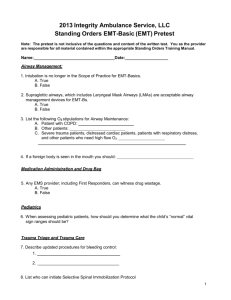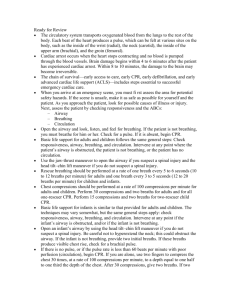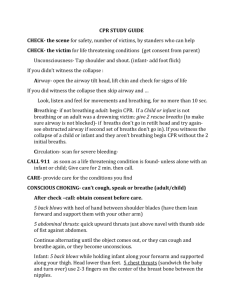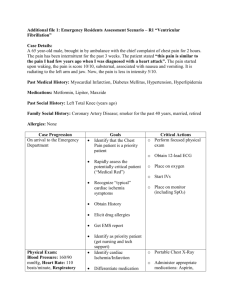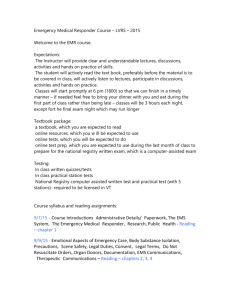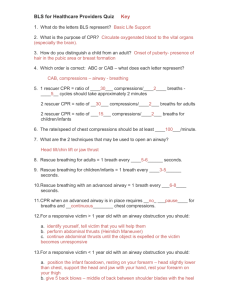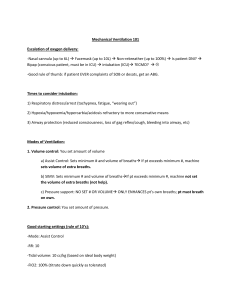2013_AEMT_PreTest
advertisement
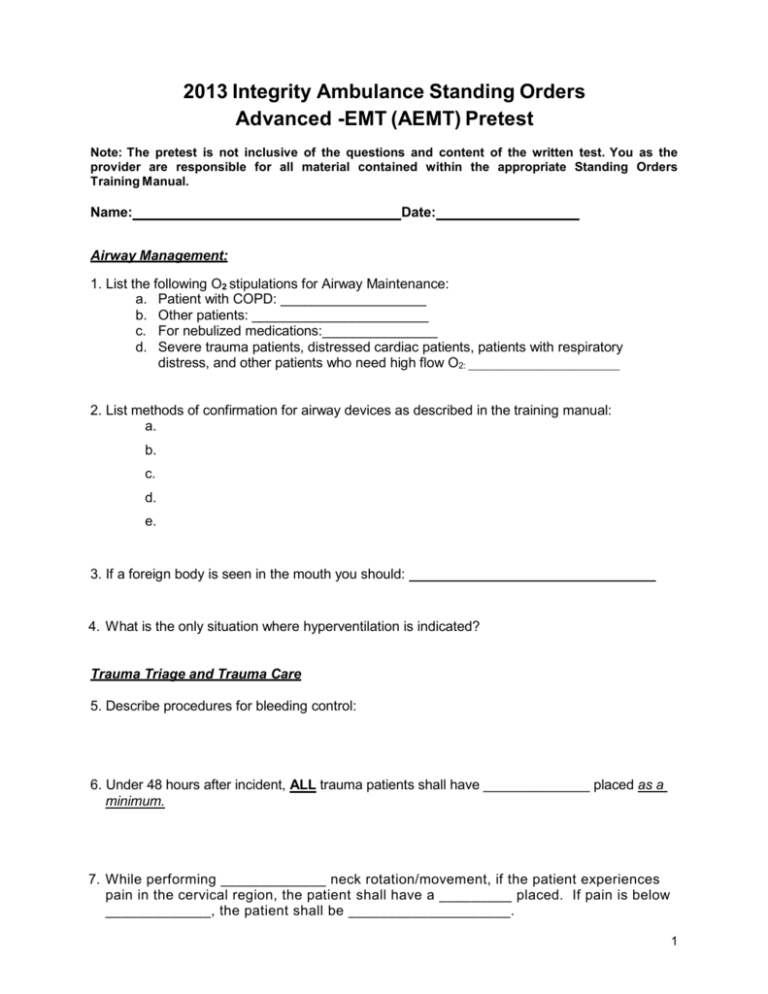
2013 Integrity Ambulance Standing Orders Advanced -EMT (AEMT) Pretest Note: The pretest is not inclusive of the questions and content of the written test. You as the provider are responsible for all material contained within the appropriate Standing Orders Training Manual. Name: Date: Airway Management: 1. List the following O2 stipulations for Airway Maintenance: a. Patient with COPD: ___________________ b. Other patients: _______________________ c. For nebulized medications:_______________ d. Severe trauma patients, distressed cardiac patients, patients with respiratory distress, and other patients who need high flow O2: _______________________________ 2. List methods of confirmation for airway devices as described in the training manual: a. b. c. d. e. 3. If a foreign body is seen in the mouth you should: 4. What is the only situation where hyperventilation is indicated? Trauma Triage and Trauma Care 5. Describe procedures for bleeding control: 6. Under 48 hours after incident, ALL trauma patients shall have ______________ placed as a minimum. 7. While performing _____________ neck rotation/movement, if the patient experiences pain in the cervical region, the patient shall have a _________ placed. If pain is below _____________, the patient shall be ____________________. 1 8. Regardless of timing, a patient ______ years old shall be fully immobilized if they remain _________ or were placed into bed immediately after the fall and not moved further. 9. The definition of a distracting injury is one that: 10. Describe recommendations for the use of tourniquets in hemorrhage control: Cardiac Emergencies, BLS and Advanced Directives 11. List the joules protocol when performing pediatric defibrillation: 12-25. Fill in the following chart per the 2010 AHA CPR Guidelines: ADULTS CHILDREN At Least Inches ½ Depth Of Chest (About ”) INFANTS NEWBORNS CPR ORDER COMPRESSION DEPTH COMPRESSION RATE COMPRESSION NOTES COMPRESSION TO BREATHS RATIO ADVANCED AIRWAY RESCUE BREATHING at least Depth Of Chest (About “) per minute /MIN Minimize interruptions in chest compressions Attempt to limit interruptions to < seconds : : 1 Person CPR 1 OR 2 : 2 Person CPR Person CPR breath every seconds ( breaths/min.) About 1 sec per breath duration No interruptions for compressions 1 breath every seconds ( breaths/min) 1 breath every seconds ( - breaths/min) 26. The Post Arrest Protocol begins with : breaths /min. - breaths/min . 27. The PATH Protocol may be used for trauma patients. a. True b. False 2 28. What factors should be considered when deciding to ventilate or intubate a patient? Chest Pain, MI, CVA 29. Recent evidence shows that ________________ and good _______________ significantly impact survival rates from pre-hospital cardiac arrest. 30. List the H’s and T’s of Trauma/Cardiac Arrest and possible ways to manage in the prehospital environment: 31. Field Termination may be initiated for any age patient True _____ False _____ 32. An EMT-I is required to transmit 12-lead EKGs to a hospital when they consider it to be negative. A. True B. False Medication Administration and Drug Bag 33. How is epinephrine 1:1000 supplied in the drug bag? _______mg/_____ml____ The Epi dosage (1:1000) for adult anaphlyaxis is _____mg; which equals ____ ml. 34Describe D10 indications, dosage and route and note specific stipulations for A. Adult Patients: B. Pediatric Patients: 35. Nebulized medications should be delivered with oxygen at a flow rate of lpm. 36. Describe your actions when valium is not available in the Drug Bag due to shortages: 37. How is versed supplied in the drug bag? ________mg/______ml. Adult seizure dose is ___mg: which equals ___ml. 3 38. In the Integrity Protocols, “slow IV” drugs are to be given over minutes. 39. Any EMS provider; including First Responders, can witness drug wastage. A. True B. False 40. When must a Controlled Drug Usage form be completed? When is a witness signature required? OB, GYN, Newborn Resuscitation 41. Describe treatment of the hypoglycemic newborn: Pediatrics 42. When assessing pediatric patients, how should you determine what the child’s “normal” vital signs ranges should be? 43. APGAR scores should be obtained ______ and ______ minutes after birth. 44. Describe chest pain management for the pediatric patient: 45. When a pediatric patient shows signs of cerebral herniation, the provider should provide respiratory ventilations at a rate of _______ than normal. 4
